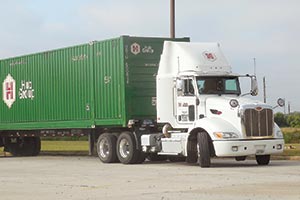Little Optimism About 1Q Earnings Due to Economy, Capacity Surplus

This story appears in the April 11 print edition of Transport Topics.
A sluggish U.S. economy and a surplus of freight capacity are creating little optimism about first-quarter earnings reports that begin arriving this week from publicly traded carriers, analysts said.
The modest expectations stem from assessments that earnings for a group of 25 truckload, logistics and other companies are expected to decline less than 1% overall, based on a Transport Topics evaluation of per-share estimates compiled by Bloomberg News. Eleven of those companies are expected to post higher earnings, with the largest increases at Hub Group Inc. and Echo Global Logistics, which rank Nos. 29 and 35 on the Transport Topics Top 50 list of the largest North American logistics companies. Twelve declines are expected, with the largest drops at ArcBest Corp. and Celadon Group Inc. Werner Enterprises Inc. and Radiant Logistics Inc. results are expected to be unchanged.
ArcBest, Celadon and Werner rank Nos. 12, 42 and 16, respectively, on the Transport Topics Top 100 list of the largest U.S. and Canadian for-hire carriers. Radiant ranks No. 48 on the TT Logistics 50.
“There is an overhang from a lot of capacity that came into the market,” said Todd Fowler, an analyst at Keybanc Capital Markets in Cleveland, who cited near-record 2015 equipment purchases, fewer bankruptcies and improved driver retention as the main reasons for the surplus in freight capacity relative to demand.
Cowen & Co. analyst Jason Seidl offered a more blunt assessment, telling TT, “We are going to see lackluster earnings overall from the trucking sector and a lackluster outlook. January freight trends were terrible, February was better and March was just all right.”
At the same time, trucking analysts qualified their limited expectations by saying that the business environment could be worse.
“Underlying demand trends are ‘less bad’ but still soft,” said Benjamin Hartford, an analyst at Robert W. Baird & Co.
“Coming into 2016, there was a lot of concern that the bottom was falling out of the economy,” Fowler said. “There is a realization now that there is not robust growth, but the economic situation isn’t as bad as some feared it would be. Things are more stable in the economy.
He added: “I wouldn’t say everyone’s earnings are going to be flattish. I think you will see a bifurcation” between truckload and logistics businesses.
Analysts agreed that truckload businesses would fare worse than brokers.
Truckload, the largest industry sector, will feel downward pressure largely because of the weak spot market and deteriorating prices for used trucks, Fowler and others said. Just four of 14 companies that rely on truckload are expected to better 2015 first-quarter performance, according to TT’s review.
Truckload spot-market rates trailed last year’s first quarter by 15%, Fowler said. The weaker used market, which has fallen nearly 10% year-over-year and is down 20% from its 2015 peak, will limit truckload profits from equipment sales, he said.
Seidl, who described the used-truck market as “stone cold,” said truckload fleets also have suffered a “rough bid season” as expectations for 2% or more rate growth in contracts with shippers haven’t materialized.
Instead, anecdotal reports cited by all three analysts, as well as Stifel Nicolaus’ John Larkin, have signaled that contract rates have risen 1% at most and have been lower than 2015 levels in some cases. Evidence of the weakness was the March 17 truckload rate report by Cass Information Systems and Avondale Partners, which showed rates averaged just 0.45% year-over-year growth in the first two months of 2016.
“It is the truckload carriers and intermodal operators that will shoulder much of the [rate] burden,” Larkin said.
He also believes that brokers and logistics operators will come under increasing pressure later this year “as shippers wake up to the realities of the freight markets and ask to fully participate in the price reductions available to their third-party intermediaries, who are always slow to pass full savings along to customers.”
More immediately, brokers’ earnings are expected to improve as they improve margins by capitalizing on weak spot prices to lower their costs, analysts said.
In the package sector,UPS Inc. earnings are expected to rise to $1.22 per share from $1.12, according to Bloomberg News’ compilation of per-share data. The company ranks No. 1 on the for-hire TT100.
LTL carriers are in a relatively better position, the analysts said, because they have maintained pricing discipline and the underlying economy that isn’t as weak as some expected when 2016 began.
Per-share earnings at leasing specialist Ryder System, which ranks No. 13 on the for-hire TT100, are expected to fall about 3% to $1.05.
Analysts were divided about how freight-sector earnings will perform relative to the average estimates.
Hartford said he expects that overall results will top expectations because of “the combination of very favorable winter weather, an early Easter holiday and a leap year working day benefit.”
However, Hartford cautioned that the months ahead could be challenging as “core pricing growth continues to decelerate [and] underlying demand trends remain soft.”
Fowler, on the other hand, believes results on average will be slightly worse than expectations for several reasons.
“The fundamental market was a little bit weaker on the utilization and pricing side,” he said. “We didn’t see the normal end-of-quarter [freight] ramp-up in March, and spot pricing was weak.”




